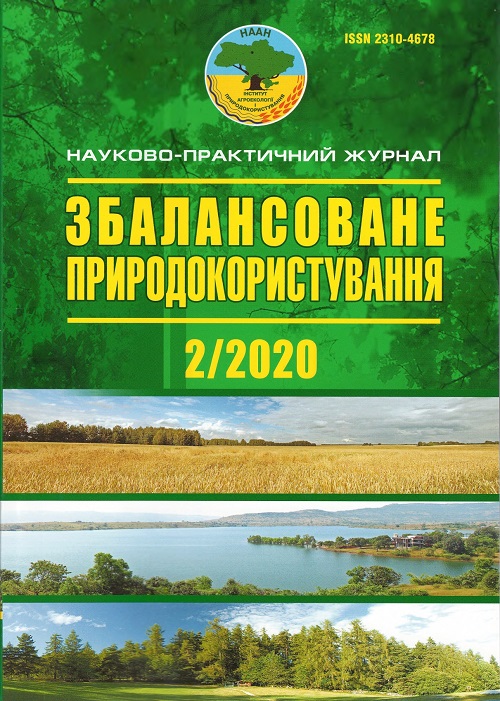Лікарське рослинництво – один із напрямів розвитку сільськогосподарського виробництва
DOI:
https://doi.org/10.33730/2310-4678.2.2020.208769Ключові слова:
валеріана лікарська, м’ята перцева, ромашка лікарська, ехінацея пурпурова, сільське господарствоАнотація
У статті визначено роль лікарського рослинництва у сільському господарстві. Функціями лікарських рослин є: задоволення потреб організму у поживних речовинах; пригнічення хвороботворної мікрофлори організму; посилення припливу крові до окремих органів; посилення видільних (секреторних) функцій організму; антиалергічна дія; припинення кровотеч; вплив на центральну нервову систему. Найпоширеніші у сільській місцевості та прибутковими для вирощування є ромашка лікарська — середня урожайність в середньому становить 5–10 ц/га, може приносити дохід до 300 тис. грн; материнка звичайна — хороший медонос з продуктивністю до 100 кг/га; меліса лікарська — за врожайності 220–250 ц/га сирої маси, або ж 35–40 ц/га сухої трави можна отримати близько 35 кг/га ефірної олії і дохід близько $8000 за 1 ц сухої маси; валеріана лікарська — урожайність становить від 7–9 до 15–20 ц/га, можна отримати до 240 тис. грн/100 кг; м’ята перцева — за урожайності 15–20 ц/га сукупний дохід становитиме від 60 до 80 тис. грн; ехінацея пурпурова — урожайність становить близько 4 т/га сухої трави і до 2 т/га коренів, прибуток до 80 тис. грн/1га за траву і до 200 тис. грн за корені. При виробництві лікарської рослинної сировини слід ґрунтуватися на соціо-еколого-економічних чинниках, які включають в себе: якісний та кількісний стан природних ресурсів, можливість зростання доходу від вирощування лікарської сировини; доходи у вигляді заробітної плати, створення нових робочих місць; зміцнення фізичного та морального здоров’я населення. Встановлено, що лікарські культури є більш прибутковими у вирощуванні, ніж сільськогосподарські.
Посилання
Pro nasinnja i sadyvnyjmaterial: Zakon Ukrajiny vid 26.12.2002. No. 411-IV. [About seeds and planting material: Law of Ukraine dated December 26.2002. No. 411-IV]. URL: http://zakon.rada.gov.ua/laws/show/411-15 [In Ukrainian].
Solodovnychenko, N.M., Zhuravljov, M.S., Kovaljov, V.M. (2001). Likarsjka roslynna syrovyna ta fitopreparaty. Posib. z farmakoghnoziji z osnovamy biokhimiji likar. roslyn. [Medicinal plant raw materials and phytopreparations. Manual of pharmacognosy with the basics of biochemistry of medicinal plants]. Kharkiv: NFAU: Zolotistorinky [In Ukrainian].
Annamukhammedova, O.O., Annamukhammedov, A.O. (2014). Likarsjki roslyny: navch. posibnyk [ dlja studentiv vyshh. navch. zakl.] [Medicinal plants: textbook. manual [for students of higher educational institutions]. Zhytomyr: ZhDU [In Ukrainian].
Tovstukha, Je.S. (1990). Fitoterapija. [Phytotherapy]. Kyiv: Zdorovja [In Ukrainian].
Ghrodzinsjkyj, A.M. (Eds.). (1992). Likarsjki roslyny: encyklopedychnyj dovidnyk [Medicinal plants: encyclopedic reference book]. Kyiv [In Ukrainian].
Z polja — do apteky [From the field — to the pharmacy]. (n.d.). URL: https://propozitsiya.com/ua/zpolya-do-apteki [In Ukrainian].
Vyroshhuvannja romashky mozhe prynosyty prybutok 300 tysjach ghrn. z ghektara [Growing chamomile can bring a profit of 300 thousand UAH. per hectare]. URL: https://superagronom.com/news/4248-viroschuvannya-romashki-moje prinositi-pributok-300-tisyach-grn-z-gektara [In Ukrainian].
Materynka abo oreghano. Jak vyrostyty, kolyzbyraty, ta jak zberighaty [Oregano or oregano. How to grow, when to collect, and how to store]. URL: https://poradnyk.com.ua/cikavo_znaty/1355-materynka-abooregano-yak-vyrostyty-koly-zbyraty-ta-yak-zberigaty [In Ukrainian].
Vony narodylysja v dykij pryrodi, ta varto jikh pereselyty na kuljturni ploshhi — budutj pid rukojui prjanoshhi, i liky [They were born in the wild, but should be relocated to cultivated areas — will be at hand and spices, and medicines]. URL: http://ridneselo.com/node/ [In Ukrainian].
TOP-5 najperspektyvnishykh likarsjkykh Roslyn dlja fermeriv [TOP-5 most promising medicinal plants for farmers]. URL: https://kurkul.com/spetsproekty/332-top-5-nayperspektivnishih-likarskih-roslindlya-fermeriv [In Ukrainian].
Valeriana: vlastyvosti ta protypokazy, jakzbyraty I sushyty [Valerian: properties and contraindications, how to collect and dry]. URL: https://floristics.info/ua/statti/sadivnitstvo/4132-valeriana-vlastivostita-protipokazi-yak-zbirati-i-sushiti [In Ukrainian].
Gubanov, A. Vyrashchivanie lekarstvennykh rasteniy — delo pribylnoe [Cultivation of medicinal plants — a profitable business]. URL: http://agrosev.narod.ru/page149itemid897number27 [In Russian].
Sologhub, Ju.O. (2018). Ekologho-ekonomichnyj mekhanizm zbalansovanogho rozvytku likarsjkogho roslynnyctva [Ecological and economic mechanism of balanced development of medicinal plant growing]. Candidate’sthesis. Kyiv [In Ukrainian].
Zinovchuk, N.V. (2007). Ekologhichna polityka v APK: ekonomichnyj aspekt. [Environmental policy in the agro-industrial complex: economic aspect]. Ljviv «ATB» [In Ukrainian].
Fedko, R.M., Shevchenko, T.L., Kalinina, M.A., Fedko, L.A. (2019).Vyroshhuvannya likarskyx roslyn na silskyx selitebnyx terytoriyax: perevagy ta problemy.[Cultivation of medicinal plants in rural areas: advantages and problems]. Visnyk agrarnoyi nauky. No. 7 (796). Pp. 68–75 [In Ukrainian].
Krokhtjak, O.V. (2016). Porivnjaljnyj analiz metodychnykh pidkhodiv do ocinky zemeljnykh resursiv [Comparative analysis of methodological approaches to land resources assessment]. Visnyk ZhNAEU. No. 2 (54). T. 2. Pp. 14–19 [In Ukrainian].
Tekhnologiya vozdelyvaniya lekarstvennykh rasteniy: uchebno-metodicheskiy kompleks (dlya studentov, obuchayushchikhsya po spetsialnosti 110201 «Agronomiya»). [The technology of cultivation of medicinal plants: an educational and methodical complex (for students enrolled in the specialty 110201 «Agronomy»)]. (2009). Gorno-Altaysk: RIOGAGU [In Russian].
Cherkashina, Ye.V. (2014). Osnovy formirovaniya efiromaslichnoy i lekarstvennoy otrasli strany. Sovremennye problem nauki I obrazovaniya No. 1]. [Fundamentals of the formation of the essential oil and drug industries of the country. Modern problems of science and education. No. 1.]. URL: http://www.science-education.ru/115-11492 [In Russian].
Voronecjka, I.S. (2013). Formuvannja rynku ekologhobezpechnoji produkciji na osnovi ekologhichnogho marketynghu [Formation of the market of ecologically safe production on the basis of ecological marketing]. Aghro Svit. — Agro Svit. No. 5. Pp. 23–26 [In Ukrainian].
Nalezhna praktyka kultyvuvannya i zboru likarskyx roslyn (GACP) yak garantiya yakosti likarskoyi roslynnoyi syrovyny i preparativ na yiyi osnovi [Good practice of cultivation and collection of medicinal plants (GACP) as a guarantee of quality of medicinal plant raw materials and preparations based on it]: naukovo-prakt. posib. Kyiv: Komitetspryyannyaborotbi z ekonomichnoyuzlochynnistyu i korupciyeyu, 2013. P. 104 [In Ukrainian].
The official site of the State Statistics Service of Ukraine. URL: http://www.ukrstat.gov.ua/ [In Ukrainian].
##submission.downloads##
Опубліковано
Номер
Розділ
Ліцензія
- Автори залишають за собою право на авторство своєї роботи та передають журналу право першої публікації цієї роботи на умовах ліцензії Creative Commons Attribution License, котра дозволяє іншим особам вільно розповсюджувати опубліковану роботу з обов'язковим посиланням на авторів оригінальної роботи та першу публікацію роботи у цьому журналі.
- Автори мають право укладати самостійні додаткові угоди щодо неексклюзивного розповсюдження роботи у тому вигляді, в якому вона була опублікована цим журналом (наприклад, розміщувати роботу в електронному сховищі установи або публікувати у складі монографії), за умови збереження посилання на першу публікацію роботи у цьому журналі.
- Політика журналу дозволяє і заохочує розміщення авторами в мережі Інтернет (наприклад, у сховищах установ або на особистих веб-сайтах) рукопису роботи, як до подання цього рукопису до редакції, так і під час його редакційного опрацювання, оскільки це сприяє виникненню продуктивної наукової дискусії та позитивно позначається на оперативності та динаміці цитування опублікованої роботи (див. The Effect of Open Access).


